Introduction
Welcome to the exciting world of ETF trading! If you’re unfamiliar with the term, don’t worry – we’re here to guide you through it. ETFs, or Exchange-Traded Funds, have become increasingly popular in the investment world due to their flexibility, diversification benefits, and ease of trading.
ETFs provide an opportunity for traders to gain exposure to a wide range of assets, including stocks, bonds, commodities, and more. Whether you’re a seasoned investor or just starting out, understanding the basics of ETF trading can help you make informed decisions and potentially grow your wealth.
In this article, we’ll delve into the fundamentals of ETF trading and give you a comprehensive overview of how it works. We’ll explore different types of ETFs, discuss the advantages and risks of trading them, and provide valuable tips to help you navigate the market. By the end, you’ll have a solid foundation to dive into the world of ETF trading confidently.
Before we jump into the specifics, it’s important to note that ETFs have gained popularity mainly because they combine the features of both stocks and mutual funds. Like stocks, they are traded on stock exchanges, which means you can buy and sell them throughout the trading day. However, unlike individual stocks, ETFs offer diversification by having a portfolio of underlying assets, similar to mutual funds.
The attractiveness of ETFs lies in their ability to provide exposure to a particular market segment or sector without requiring you to purchase each individual stock or bond. This not only offers cost savings but also allows you to easily diversify your portfolio and mitigate risk.
Over the years, ETFs have evolved to cover a wide range of investment categories. From broad-based index ETFs that track popular indices like the S&P 500, to sector-specific ETFs that focus on industries such as technology or healthcare, there is a vast array of options available to suit different investment strategies and goals.
What is an ETF?
An ETF, or Exchange-Traded Fund, is a type of investment fund that trades on stock exchanges, similar to individual stocks. It is designed to provide investors with exposure to a diversified portfolio of assets, such as stocks, bonds, commodities, or a combination of these, while offering the flexibility and liquidity of stock trading.
Unlike mutual funds, which are priced at the end of the trading day, ETFs can be bought and sold throughout the trading day at market prices. This real-time trading feature allows investors to react quickly to market movements and adjust their positions accordingly.
ETFs are created and managed by financial institutions, such as asset management companies or investment banks. They pool together funds from multiple investors and use the money to purchase the underlying assets that the ETF is designed to track. These assets could be stocks of companies in a specific index, bonds issued by governments or corporations, or even physical commodities like gold or oil.
One of the key features of ETFs is that they aim to replicate the performance of a specific index or benchmark. For example, an ETF tracking the S&P 500 index would hold a basket of the 500 largest U.S. companies, weighted according to their market capitalization. By doing so, investors can gain exposure to a broad market segment without having to buy all the individual stocks individually.
It’s important to note that while many ETFs aim to closely track their underlying indexes, there can be slight variations due to factors such as fees and transaction costs. These tracking differences are known as tracking error and can impact the ETF’s performance relative to its benchmark.
Another notable aspect of ETFs is their ability to offer intraday liquidity. Investors can buy or sell ETF shares on the stock exchange at any time during trading hours, similar to trading individual stocks. This liquidity makes ETFs an attractive option for both short-term traders looking to capitalize on market movements and long-term investors seeking to build a diversified portfolio.
In summary, ETFs are investment funds that trade on stock exchanges, providing investors with exposure to diversified portfolios of assets. They offer the benefits of real-time trading, flexibility, and liquidity, making them a popular choice among investors who are looking for a cost-effective and convenient way to invest in diverse markets.
How ETFs Work
To understand how ETFs work, let’s break down the process step by step. When an ETF is created, an authorized participant, typically a large institutional investor, works with the ETF issuer to create a new block of shares. This is done by depositing a portfolio of underlying assets with the ETF issuer, such as stocks or bonds. In return, the authorized participant receives creation units, which are large blocks of ETF shares.
Once the creation units are obtained, the authorized participant can sell the ETF shares on the stock exchange to individual investors like you and me. Conversely, if an investor wants to redeem their ETF shares, they can do so through an authorized participant, who will then exchange the shares for the underlying assets.
The price at which ETF shares are bought and sold on the stock exchange is determined by supply and demand. This means that the price may trade at a premium or discount to the net asset value (NAV) of the underlying assets. However, market participants, including institutional investors called market makers, work to keep the price in line with the NAV by arbitraging any discrepancies.
ETFs also have a creation-redemption mechanism that helps keep the number of shares in line with investor demand. If there is a high demand for an ETF, the authorized participant can create more shares by depositing more underlying assets with the ETF issuer. Conversely, if there is a low demand, the authorized participant can redeem shares by returning the underlying assets to the ETF issuer.
This creation-redemption process helps ensure that the supply of ETF shares can meet the demand from investors. It also allows the ETF to have a low expense ratio compared to traditional mutual funds, as the creation and redemption of shares help keep trading costs and capital gains taxes low.
Investors can buy and sell ETF shares through a brokerage account, similar to buying and selling individual stocks. When purchasing ETF shares, investors can place market orders, limit orders, or stop orders, depending on their desired execution strategy. It’s important to note that investors will incur brokerage commissions and fees when trading ETF shares, so it’s essential to consider these costs as part of your overall investment plan.
In summary, ETFs work by allowing authorized participants to create new shares by depositing a portfolio of underlying assets with the ETF issuer. These shares can then be bought and sold on the stock exchange by individual investors. ETF prices are determined by supply and demand, and the creation-redemption mechanism helps ensure that there is sufficient liquidity in the market. Investors can trade ETF shares through a brokerage account, with various order types available to meet their trading needs.
Types of ETFs
ETFs come in a wide variety of types, each designed to meet different investment objectives and strategies. Here are some of the most common types of ETFs available in the market:
- Index ETFs: These ETFs aim to replicate the performance of a specific index, such as the S&P 500 or the Nasdaq 100. They hold a portfolio of securities that closely match the composition and weighting of the underlying index.
- Sector ETFs: Sector ETFs focus on specific industry sectors, such as technology, healthcare, or energy. They allow investors to gain exposure to the performance of a particular sector without having to pick individual stocks.
- Commodity ETFs: Commodity ETFs provide exposure to physical commodities like gold, silver, oil, or agricultural products. They can be an effective way to diversify a portfolio or hedge against inflationary pressures.
- Bond ETFs: Bond ETFs invest in a portfolio of bonds, such as government bonds, corporate bonds, or municipal bonds. They can provide access to fixed income securities with different durations, credit qualities, and interest rate exposures.
- International ETFs: International ETFs offer exposure to stocks or bonds of companies or countries outside the investor’s home country. They allow investors to diversify globally and potentially benefit from the growth of international markets.
- Inverse ETFs: Inverse ETFs are designed to deliver the opposite performance of an underlying index or asset. They use derivatives to achieve this inverse exposure, making them suitable for investors who wish to profit from declining markets or hedge existing positions.
- Leveraged ETFs: Leveraged ETFs use derivatives and borrowing to amplify the returns of the underlying index or asset. They aim to deliver a multiple (e.g., 2x or 3x) of the daily performance, making them suitable for traders seeking magnified short-term gains.
- Smart Beta ETFs: Smart Beta ETFs employ alternative weighting methodologies to traditional market-cap-based indexes. They aim to enhance returns or reduce risk by selecting stocks based on factors like value, quality, or momentum.
- Multi-Asset ETFs: Multi-Asset ETFs invest in a diversified portfolio of different asset classes, such as stocks, bonds, and commodities. They provide a one-stop solution for investors seeking a balanced and diversified portfolio in a single investment.
It’s important to note that while these are some of the common types of ETFs, the universe of ETF offerings is vast and continually evolving. New types of ETFs with innovative strategies and themes are introduced regularly, providing investors with even more opportunities to tailor their portfolios to their specific investment goals and preferences.
Advantages of ETF Trading
ETF trading offers several advantages that have contributed to their popularity among investors. Here are some key benefits of trading ETFs:
- Diversification: ETFs provide instant diversification by holding a basket of underlying assets. This reduces the risk of investing in individual securities and helps spread exposure across different sectors, regions, or asset classes.
- Liquidity: ETFs trade on stock exchanges throughout the trading day, allowing investors to buy and sell shares at market prices. This provides liquidity and flexibility, enabling investors to take advantage of short-term market movements or adjust their positions as needed.
- Low Costs: ETFs generally have lower expense ratios compared to mutual funds. This is because they are passively managed and designed to track an index rather than employing active fund management strategies. Additionally, ETFs offer transparency of holdings and lower transaction costs due to their creation-redemption mechanism.
- Accessibility: ETFs can be bought and sold through brokerage accounts, making them accessible to individual investors. There is no minimum investment requirement, allowing investors to start with small amounts and gradually add to their positions over time.
- Flexibility in Trading Strategies: ETFs offer a range of strategies for different investor preferences. Investors can use ETFs for long-term investment, short-term trading, or even as a tool for tactical asset allocation. Additionally, the availability of inverse and leveraged ETFs allows investors to profit from falling markets or magnify returns, providing additional flexibility in trading strategies.
- Transparency: The majority of ETFs disclose their holdings on a daily basis, giving investors full visibility into the assets held by the fund. This transparency allows investors to monitor the underlying securities and make informed decisions about their investments.
- Tax Efficiency: ETFs are structured in a way that can provide tax advantages to investors. The creation-redemption mechanism helps minimize capital gains distributions, and investors have control over when to realize taxable events by deciding when to buy or sell shares.
These advantages make ETF trading an attractive option for investors looking for cost-effective, diversified, and flexible investment opportunities. However, it’s essential to understand the risks associated with ETFs and carefully consider your investment objectives and risk tolerance before investing.
Risks and Challenges of ETF Trading
While ETF trading offers various advantages, it’s important to be aware of the risks and challenges involved. Understanding these factors can help investors make informed decisions and manage their portfolios effectively. Here are some key risks and challenges to consider when trading ETFs:
- Market Volatility: Like all investments, ETFs are subject to market volatility. The value of an ETF can fluctuate based on the performance of its underlying assets, which can be influenced by factors such as economic conditions, geopolitical events, or industry-specific developments.
- Liquidity Risk: While ETFs are generally highly liquid, certain ETFs with lower trading volumes or those invested in less liquid underlying assets may have wider bid-ask spreads, which can impact the cost of buying or selling shares. Additionally, during periods of market stress or heightened volatility, ETF liquidity could be temporarily reduced.
- Tracking Error: ETFs aim to closely track their underlying indexes, but there can be slight variations known as tracking error. This can occur due to factors such as fees, transaction costs, or imperfect replication of the index. It’s important to monitor an ETF’s tracking error to assess its performance relative to its benchmark.
- Concentration Risk: Some ETFs may have a concentrated exposure to a specific industry, sector, or region. While this may provide targeted investment opportunities, it also increases the risk in the event of adverse developments impacting that particular area of the market.
- Counterparty Risk: Certain types of ETFs, such as leveraged or inverse ETFs, may use derivatives or engage in financial contracts with counterparties. This introduces counterparty risk, which is the risk that the counterparty may fail to fulfill its obligations, potentially resulting in losses for the ETF.
- Tax Implications: While ETFs offer tax advantages, investors should be aware of potential tax consequences. Capital gains distributions from the sale of underlying securities can trigger tax liabilities for investors, and tax treatment may vary based on individual circumstances and local tax laws.
- Investor Behavior: Emotional decision-making, such as buying or selling ETFs based on short-term market fluctuations, can lead to poor investment outcomes. It’s important to have a well-defined investment plan and stick to it, focusing on long-term goals rather than reacting to short-term market noise.
To mitigate these risks, investors should conduct thorough research, diversify their portfolios, carefully consider their risk tolerance, and create a disciplined investment strategy. It’s also essential to stay informed about market and economic developments that may impact the performance of ETFs.
Remember, ETFs are not risk-free investments, and the risks associated with them should be carefully evaluated in relation to your investment objectives and risk appetite.
How to Start Trading ETFs
If you’re ready to start trading ETFs, here are some steps to help you get started:
- Educate Yourself: Begin by learning about the basics of ETFs, their features, and how they work. Understand the different types of ETFs available and their associated risks and rewards. Take advantage of reputable educational resources, such as online courses, books, or articles, to enhance your knowledge.
- Define Your Investment Goals: Determine your investment objectives and risk tolerance. Consider factors such as your time horizon, desired level of diversification, and income requirements. This will help guide your ETF selection process and inform your investment strategy.
- Select a Brokerage Account: Open a brokerage account with a reputable online broker that offers access to a wide range of ETFs. Consider factors such as trading fees, research tools, customer support, and the overall user experience when choosing a brokerage.
- Research and Evaluate ETFs: Conduct thorough research on different ETFs that align with your investment goals. Look at factors such as the fund’s expense ratio, historical performance, tracking error, and the underlying index or assets. Evaluate the fund’s holdings, diversification, and any specific strategies employed by the ETF issuer.
- Monitor and Track Performance: Regularly review the performance of your chosen ETFs to ensure they continue to align with your investment objectives. Keep an eye on expense ratios, tracking error, and any changes in the fund’s strategy or holdings. Stay informed about market and economic developments that may impact the performance of your ETFs.
- Execute Trades: Once you have selected the ETFs you want to invest in, execute your trades through your brokerage account. Determine whether you want to place market orders, limit orders, or use other order types based on your desired execution strategy. Be mindful of transaction fees and commissions associated with buying and selling ETF shares.
- Monitor your Portfolio: Regularly monitor the performance of your ETF portfolio and rebalance if necessary. Rebalancing involves adjusting your holdings to maintain your desired asset allocation. This could involve selling overweight positions and buying underweight positions to bring your portfolio back in line with your investment plan.
- Stay Informed: Continuously educate yourself about the ETF market and seek opportunities to enhance your investment knowledge. Stay updated on market trends, economic news, and changes in regulations that may impact the ETF landscape. This will help you make informed decisions and adapt your investment strategy as needed.
Remember, investing in ETFs carries risks, and it’s important to carefully evaluate your investment goals and risk tolerance before trading. Regularly review your portfolio and consult with a financial advisor if needed to ensure your investment strategy aligns with your goals and needs.
Tips for Successful ETF Trading
To have a successful ETF trading experience, consider the following tips:
- Do Your Research: Thoroughly research and understand the ETFs you plan to trade. Consider factors such as the fund’s objective, underlying assets, performance history, and expense ratio. Use reliable sources and leverage the research tools provided by your brokerage to make informed decisions.
- Diversify Your Portfolio: Maintain a diversified portfolio by investing in a mix of different ETFs across various asset classes and sectors. Diversification can help mitigate risk and increase the potential for long-term gains. Avoid over-concentration in a single ETF or sector.
- Consider Liquidity: Pay attention to the liquidity of the ETFs you trade. ETFs with higher trading volumes generally have tighter bid-ask spreads, providing better opportunities for executing trades at favorable prices. Avoid trading in low-volume or illiquid ETFs, as it may impact your ability to buy or sell shares at desired prices.
- Set Realistic Expectations: Have realistic expectations about the performance of your ETFs. ETFs are designed to track the performance of an index or asset class, and while they aim to closely replicate the benchmark, there may be slight variations due to fees and market conditions. Avoid chasing short-term trends and focus on long-term objectives.
- Monitor Expenses: Consider the expense ratio of an ETF as it directly impacts your returns. Look for low-cost ETFs, especially those that aim to track widely followed indexes. Even small differences in expense ratios can have a significant impact on your long-term investment outcomes.
- Review and Adjust Regularly: Periodically review your ETF holdings and evaluate their performance relative to your investment goals. Adjust your portfolio as needed by adding or removing ETFs to maintain diversification and align with your evolving investment strategy. Regularly rebalance to ensure your asset allocation stays in line with your objectives.
- Be Mindful of Trading Costs: Consider the trading costs associated with buying and selling ETFs, such as commissions, bid-ask spreads, and any transaction fees. Frequent trading can add up and eat into your returns. Plan your trades strategically and consider using limit orders to control your execution prices.
- Keep Emotions in Check: Emotions can impact trading decisions and lead to costly mistakes. Avoid making impulsive decisions based on short-term market movements. Stick to your investment plan and long-term objectives, focusing on your overall financial goals rather than trying to time the market.
- Stay Informed: Continuously educate yourself about the market, economic conditions, and the factors that can influence the performance of your ETFs. Stay updated on news and developments that may impact the sectors or asset classes your ETFs are exposed to. Consider following reliable financial news sources and industry publications to stay informed.
- Consider Professional Guidance: If you’re uncertain about ETF trading or need assistance in building and managing your portfolio, consider consulting with a financial advisor. A professional can help you evaluate your investment goals, risk tolerance, and provide personalized advice based on your unique circumstances.
Remember that successful ETF trading takes time, patience, and discipline. Continuously refine your strategy, learn from your experiences, and adapt to market conditions to improve your chances of achieving your investment objectives.
Conclusion
ETF trading offers investors a convenient and flexible way to gain exposure to a diversified portfolio of assets. With their advantages such as diversification, liquidity, and low costs, ETFs have become popular investment vehicles for both seasoned and novice traders alike.
By understanding the fundamentals of ETFs, such as how they work, the different types available, and the associated risks and challenges, you can make more informed decisions and build a well-rounded portfolio that aligns with your investment goals and risk tolerance.
When starting ETF trading, it’s important to educate yourself, define your investment objectives, and select a reputable brokerage account. Conduct thorough research on the ETFs you plan to trade, monitor their performance, and regularly review your portfolio to ensure it remains in line with your desired asset allocation. Additionally, be mindful of trading costs, diversify your holdings, and stay informed about market developments.
Remember that ETF trading carries risks, and it’s essential to have a disciplined investment strategy. Avoid succumbing to market emotions and seek professional guidance if needed. Successful ETF trading requires patience, knowledge, and a focus on long-term objectives.
As always, ensure you have a clear understanding of your financial goals and risk tolerance before engaging in ETF trading. By making informed decisions and staying disciplined, you can harness the benefits of ETFs to potentially grow your wealth and achieve your investment aspirations.

























